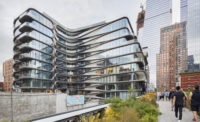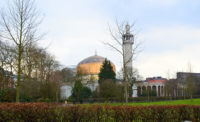Zaha Hadid Architects
London
Zaha Hadid Architects’ first permanent structure in London—a restaurant building made from tensile fabric, steel, and glass—has something of the appearance of a carnival tent. I’ve watched this building grow in Hyde Park over the past year, appearing like a white efflorescence on the side of one of London’s odder little buildings, an austerely neoclassical 1805 military gunpowder magazine. Now it has taken on a new use as the second home of the Serpentine Gallery, a short walk away.
It may not be the biggest or most dramatic of Hadid's recent work—for that one must look to Baku in Azerbaijan and her glistening white Heydar Aliyev Centre—but in architecture, client prestige and location are everything. The tiny Serpentine Gallery has a cultural reach way beyond its size, something amply demonstrated by its ambitious program of annual temporary pavilions by international architects—Sou Fujimoto this year. Hadid is a trustee of the gallery, and the chairman of its board is none other than Pritzker Prize chair Lord Palumbo. It also occupies a site within the green heart of London, the great former royal hunting grounds of the adjacent Hyde Park and Kensington Gardens. The $23.5 million spent on Hadid’s building here has an impact worth ten times that spent elsewhere.
But the Royal Parks organization is famously conservative about what—if anything—it allows to be built on its zealously-preserved land. The legendary Crystal Palace of 1851 may have stood near here, but that was temporary. A no less fierce guardian is the state conservation agency English Heritage, tasked with vetting any alteration to a building on the historic register. And so we find Hadid designing a tent-like building. The structure looks as if it could be taken down at any time, a visual fiction agreeable to the authorities.
Hadid and her firm, however, have done much more than just add this organic extension, which shares some formal preoccupations with its bigger sister in Baku. Working with traditionalist architect Liam O’Connor and noted conservation architect Julian Harrap, they have transformed the old gunpowder facility as well. This entailed roofing over the open courtyard that used to separate the original magazine from its slightly later perimeter building with its broad portico and extending the original building in replica—recycled matching bricks, stone copings, and all. This provided space for toilets, storage, and administrative offices for the gallery. From outside, few will notice the difference between old and new. Inside, the main result is a gallery circuit with perimeter top-lighting that runs around the twin massive brick-vaulted structures of the original magazine storgage facilities, now themselves acting as galleries.
The eye-catching restaurant is symmetrical in plan but more free-form in elevation. It involves some typically Hadidian structural gymnastics, delivered by Arup. The undulating steel ring-beam of the structure, given a shiny GRP (glass reinforced plastic) edging, touches the ground at only three points. There are a couple of discreet attachment points to the old building, otherwise it is separated from it by a band of glass. The main curving glass walls are freestanding, and the roof is designed to flex above it.
This extension is visually problematic externally: clumsy, uneasy, a troubling clash of materials and textures, the soft and the hard. Inside, it’s another story: suddenly elegance returns, especially in the form of the five columns tensing the roof fabric. These are hollowed on one side, broadening at the top like lilies to allow for oval skylights. Daylight washes down the stems, supplemented by artificial light fittings set around the perimeter at the top. This is very neatly done. In all, it is an airy, almost ethereal space, equipped with a bar and a rather intrusive kitchen, nonetheless perfect for parties.
Zaha’s first permanent building in London, then, is a somewhat tame affair for this Pritzker and double Stirling Prize winner. The creation of a second Serpentine Gallery, however—named for benefactors Dr. Mortimer and Dame Theresa Sackler—is a highly significant cultural event for the British capital. It means that Zaha, once an outsider here, is now officially part of the establishment.





























Post a comment to this article
Report Abusive Comment